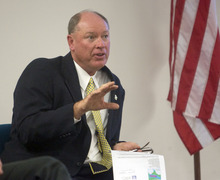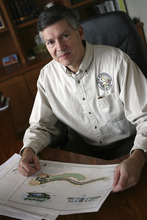This is an archived article that was published on sltrib.com in 2011, and information in the article may be outdated. It is provided only for personal research purposes and may not be reprinted.
What if the agency in charge of conserving elk, duck and fish habitat were also responsible for making sure a mile-square pile of radioactive waste never leaks?
And what if the agency probing Utah's geo-history for signs of the next big earthquake were also charged with speeding to the scene of the latest hazardous chemical spill?
That hypothetical mega-department of state government would be created under legislation proposed by Rep. Wayne Harper to combine the Utah departments of Natural Resources and Environmental Quality. HB97, said the West Jordan Republican, would promise taxpayers greater efficiency and cost savings.
"It benefits the business community," said Harper, a developer. "It benefits the environmental community and it benefits our quality of life."
But environmental and industry leaders are scratching their heads, wondering what problems exist that the consolidation is intended to solve.
Terry Marasco, of the Utah Clean Air Alliance, has heard colleagues in the environmental community use a range of verbs to describe how the consolidation would affect the Department of Environmental Quality: "diluting," "demoting" and even "eviscerating" it.
"The DEQ and [its Division of Air Quality] would become less accessible and less important," he said.
The 300-page legislation directs the head of the Department of Natural Resources, former state Rep. Mike Styler, to work with DEQ boss Amanda Smith over 15 months to meld the two agencies. The executive director of the combined agency would essentially oversee what are now Styler and Smith's roles, plus the 26 divisions within the new agency.
Harper claims creation of a new "chief environmental officer" would actually enhance the clean-environment efforts of agency employees — not undercut them — and signal that Utah sees the environment as a high-priority issue "if we get the right person in there."
Harper, who challenged DEQ funding during the many years he served on the legislative subcommittee that oversees its spending, has not released a budget analysis about what cost savings might be.
In an interview last week, he insisted his bill is not part of a libertarian push nationally to cut government regulation and end environmental regulation altogether. But he did say the DEQ could have put up stronger resistance to the Environmental Protection Agency's new greenhouse-gas regulations, as other states have done.
Utah's DEQ has improved in recent years, he said, "but it's not what we want it to be."
Harper said he had support of a couple of environmental groups and some legislators, although he would not name them. He said the new agency follows an approach that has been used in 17 other states, including North Carolina.
But others are lukewarm or cold to the idea.
Gov. Gary Herbert is reviewing the bill now, said spokeswoman Ally Isom.
"The Department of Environmental Quality and the Department of Natural Resources may have some issues in common, but they have distinctly different missions and functions," she said in an e-mail.
"The governor is not persuaded those missions and functions can be melded in a mutually beneficial way."
Neither of the current department directors supports the proposal.
Styler pointed out the consolidation is not a new idea. Queries by the Legislative Auditor General in 1995 and 1988 showed no benefit in combining the state's water programs and combining energy-related programs, he noted.
"In addition to findings in audits that revealed no significant cost savings or increased efficiencies," Styler wrote in an e-mail, "there may be significant conflicts of interest."
Smith notes that DEQ has a high level of support from the hundreds of regulated businesses that rely on her agency for pollution permits and for dealing with the EPA, which has delegated to the state the responsibility of carrying out the Clean Air Act, the Clean Water Act, hazardous waste laws and other congressional mandates.
She noted that Harper's organizational chart adds a layer of management between state regulators and the public.
"I think we are more efficient when decision-makers are closer to the public and the regulated community," she said, noting that she can take any concerns directly to the governor as an executive director.
"I don't see how [the consolidation] increases efficiency."
Smith has won supporters from both sides since she took over DEQ in the fall of 2009.
Much of that time, she has tried to make DEQ work better with less, since legislators have pared the department's budget by 27 percent in the past three years and are proposing to trim it another 7 percent in the coming budget year that begins in July. The agency's 368 employees haven't seen a raise in five years.
The Division of Radiation Control is the first of at least three DEQ programs that has undergone a "Lean Six Sigma" review, a management tool typically used by industry to streamline its operations, speed up permitting and improve public involvement.
Meanwhile, it is the business community that has raised the most questions about Harper's bill.
Many of its members see DEQ as an ally and buffer against heavy-handed management by EPA. In addition, their biggest complaint about DEQ in recent years is that the Legislature keeps cutting its funding to the point that permitting is slowed and initiatives like the industry-agency-tribal partnership to address air pollution problems in the Uintah Basin have been stymied.
The last thing they want to see is what happened recently in Texas, which was digging in against EPA's new regulations on controlling the greenhouse-gas pollution blamed for climate change. Now EPA officials carry out the law instead of state regulators there.
David Bird, an attorney and industry lobbyist who sits on the boards of the Utah Mining and the Utah Manufacturing associations, noted that, even if Harper can show his proposal would improve programs in the long run, businesses will struggle for at least a few years with uncertainty during the consolidation.
"In the short run," he said, "it's going to throw us into a tizzy," prompting businesses to question or delay decisions about expansion, investment and other plans for the future.
Tom Bingham, president of the Utah Manufacturers Association, called the changes "monumental." "We really haven't had time to get our heads around it," he said.
Spokesman Kyle Bennett said Kennecott Utah Copper's parent Rio Tinto supports the existing structure of the two departments, both of which the company deals with almost constantly.
"We also support the leadership of Governor Herbert and those he has chosen to lead those respective agencies," he added.
Rio Tinto needs to change 25 of its environmental permits in order to move forward with its plans to extend the life of the Bingham Canyon copper mine.
Brian Moench, president of the Utah Physicians for a Healthy Environment, called Harper's measure "a thinly veiled assault on the environment, which seems to be in vogue with the radical, hard right wing of the Republican Party."
Noting that even Kennecott doesn't back HB97, he added: "The bill reflects a fundamental lack of understanding that the primary purpose of environmental regulations are to protect public health. I'm not aware of anyone that is in favor of less public health protection."
fahys@sltrib.com Combining two agencies
HB97 would create a new Department of Natural Resources and Environment out of two agencies that are currently separate.
Department of Environmental Quality • Has 368 employees and a budget of $56 million, about $10.7 million of which comes from the General Fund. The other 80 percent comes from fees, federal grants and other sources besides taxes. The agency's mission, divided among seven divisions, is to protect air, land and water with an eye on the state's economic needs.
Department of Natural Resources • About three times as big; has 1,193 employees. Its budget is $182 million, $38 million of it from the taxpayer-supported General Fund. It oversees such functions as water resources, the geological survey, wildlife parks and mining.











